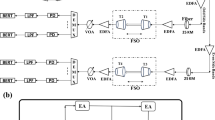Abstract
With the emergence of differentiated service applications, optical access networks have developed as the most promising reliable technology for broadband access systems. One of the most critical characteristics of the access system is dynamic bandwidth allocation (DBA) which facilitates sharing of a common upstream channel for diverse categories of bursty data. It is expected that an ideal DBA mechanism shall reserve transmission resources for higher prioritized real-time applications along with a fair allocation of best effort (BE) services. This requires a provision of prioritized service class transmission on multiple uplink wavelengths in a cost-effective manner. This paper proposes a novel improved hybrid slot size/rate (IHSSR) DBA scheme that allows data traffic with three diverse priority classes to be communicated on multiple upstream wavelengths. The transmission cycle is segmented equally into two segments, in which the first section is reserved exclusively for the highest priority-expedite forwarding data traffic. On the other hand, the remaining part of the time cycle is further distributed between two services namely assured forwarding and best effort (BE) traffic. Furthermore, the proposed IHSSR algorithm computes the minimum scheduled channel length to achieve higher channel utilization. The proposed DBA mechanism is comprehensively evaluated in terms of quality of service metrics like average frame delay, throughput, average jitter, and channel utilization on varying traffic load. The simulation results indicate an improved performance from 4 to more than 20% in comparison with similar existing schemes. The range of congestion-free traffic load is also prolonged in the proposed algorithm. Thus it can be visualized that the proposed mechanism outperforms other schemes and met its objective.





Similar content being viewed by others
Data availability
All data generated or analysed during this study are included in this published article.
Code availability
Optiwave OptiSystem is used and all the schematic generated are included in the article.
References
An, F., Hsueh, Y., & Kim, K.: A new dynamic bandwidth allocation protocol with quality of service in ethernet based passive optical networks. Proc. IASTED Int’l. Conf. Wireless and Optical Communications (WOC 2003), vol. 3, July 2003, pp. 165–69.
Berisa, T., Ilic, Z., Bazant, A.: Absolute delay variation guarantees in passive optical networks [J]. J. Lightwave Technol. 29(9), 1383–1393 (2011)
Chao, I.F., Zhang, T.M.: A high performance long-reach passive optical network with a novel excess bandwidth distribution scheme. Opt. Fiber Technol. 23, 95–103 (2015)
Dalamagkas, C., Sarigiannidis, P., Kapetanakis, S., Moscholios, I.: Dynamic scheduling in TWDM-PONs using game theory. Opt. Switch. Netw. 33, 103–113 (2019)
Hossain, A.D., Hossain, A.R.: A distributed control framework for TDM-PON based 5G mobile fronthaul. IEEE Access. 7, 162102–162114 (2019)
Hou, W., Ning, Z., Guo, L., et al.: Temporal, functional and spatial big data computing framework for large-scale smart grid [J]. IEEE Trans. Emerg. Top. Computing 7(3), 369–379 (2017)
Hou, W., Ning, Z., Guo, L.: Green survivable collaborative edge computing in smart cities [J]. IEEE Trans. Industr. Inf. 14(4), 1594–1605 (2018)
Nhat, N.D., Elsherif, M.A., Minh, H.L., Malekmohammadi, A.: NRZ versus RZ over absolute added correlative coding in optical metro access networks. Opt. Commun. 387, 30–36 (2017)
Ni, C., Gan, C., Li, W., Chen, H.: Bandwidth allocation based on priority and excess bandwidth utilized algorithm in WDM/TDM PON. Int. J. Electron. Commun. 69(11), 1659–1666 (2015)
Radivojevic, M.R., Matavulj, P.S.: Implementation of intra-ONU scheduling for quality of service support in ethernet passive optical networks. J. Lightwave Technol. 27(18), 4055–4062 (2009)
Rahman, M.M., Hossen, M.: Bandwidth allocation and control message scheduling algorithms for improving the QoS of high priority traffic in PON. J. Commun. Inf. Netw. 3(4), 112–120 (2018)
Wang, C., Wei, W., Zhang, W., Jiang, H., Qiao, C., Wang, T.: Optimal wavelength scheduling for hybrid WDM/TDM passive optical networks. J. Opt. Commun. Netw. 3(6), 522–532 (2011)
You, W.: Randomized dynamic bandwidth allocation algorithm for upstream access in OFDMA-PON. J. Opt. Commun. Netw. 07(06), 597–601 (2015)
Funding
No funds, grants, or other support was received.
Author information
Authors and Affiliations
Corresponding author
Ethics declarations
Conflict of interest
The authors have no conflicts of interest to declare that are relevant to the content of this article.
Additional information
Publisher's Note
Springer Nature remains neutral with regard to jurisdictional claims in published maps and institutional affiliations.
Rights and permissions
About this article
Cite this article
Singhal, A., Gupta, A., Singh, H. et al. A novel dynamic bandwidth allocation algorithm in optical access systems. Opt Quant Electron 53, 698 (2021). https://doi.org/10.1007/s11082-021-03358-0
Received:
Accepted:
Published:
DOI: https://doi.org/10.1007/s11082-021-03358-0




